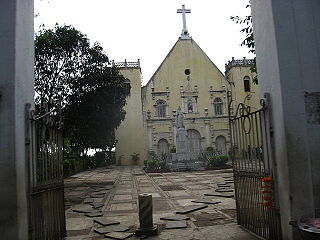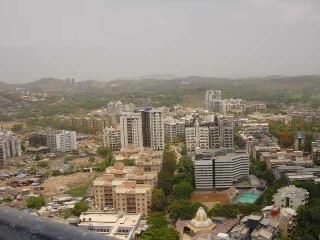Related Research Articles

Bandra ([bæːɳɖɾa]) is a coastal suburb located in Mumbai, the largest city of the Konkan division in Maharashtra, India. The area is located to the immediate north of the River Mithi, which separates Bandra from the Mumbai City district. It is the third-largest commercial hub in Maharashtra, after the Bombay city district and Pune, primarily aided by the Bandra-Kurla Complex.

Santacruz or Santa Cruz is a suburb of Mumbai. The Santacruz railway station on the Mumbai Suburban Railway, the domestic terminal (T1) of the Chhatrapati Shivaji Maharaj International Airport, and one campus of the University of Mumbai, are all located in Santacruz (East).

Juhu is a suburb of Mumbai. It is known for the sprawling Juhu Beach. It is surrounded by the Arabian Sea to the west, Versova to the north, Vile Parle to the east and Santacruz to the south. Juhu is among the most expensive and affluent areas of the metropolitan area and home to many Bollywood celebrities. The nearest railway stations are Santacruz, Andheri and Vile Parle on the Western Line and Harbour Line of the Mumbai Suburban Railway. The nearest metro stations are D. N. Nagar and Andheri West. There are two minor B.E.S.T bus depots in Juhu.

Colaba is a part of the city of Mumbai, India. It is one of the four peninsulas of Mumbai while the other three are Worli, Bandra and Malabar Hill. During Portuguese rule in the 16th century, the island was known as Kolbhat. After the British took over the island in the late 17th century, it was known as Kolio.

Khar Road is a railway station on the Western Line and the Harbour Line of the Mumbai Suburban Railway network, in the Khar suburb. It is close to the Bandra Terminus for upcountry trains.
Pali Hill is an affluent residential area spread across the adjoined suburbs of Bandra and Khar in Mumbai, India.

Salsette Island is an island in Konkan division of the state of Maharashtra, along India's west coast. Administratively known as Greater Mumbai, the Mumbai Suburban district, Mira Bhayander and a portion of Thane district lie within it, making it very populous and one of the most densely populated islands in the world. It has a population of more than 20 million inhabitants living on an area of about 619 square kilometres (239 sq mi).

Ribeira Quente is a civil parish in the municipality of Povoação in the Portuguese archipelago of the Azores. The population in 2011 was 767, in an area of 9.04 km2. It is the smallest, the lowest and the southernmost of the parishes in municipality. It contains the localities Castelo, Eira das Freiras, Fogo, Ribeira Quente, Ponta da Albufeira and Ponta do Garajau.

Gorai ([ɡoɾaːi]) is a village at Dharavi Bhet, in Mumbai, India. It is located on the North-western part of the island of Salsette. Gorai is accessed more usually by a ferry crossing the Manori Creek and Gorai creek or otherwise by the overland route through Bhayander. Gorai is bordered by the villages of Manori and Uttan, Pali, Chowk, Dongri, Tarodi, Rai, Morva and Murdhe.

Khar is an affluent suburb of Mumbai, north of Bandra and south of Santacruz, Mumbai. Originally one of the 'villages' that made up the larger Bandra, the present suburb is divided into Khar West and Khar East areas. It is serviced by Khar Road railway station of the Mumbai Suburban Railway network. It is an area within convenient distances of several schools, restaurants, parks, promenades and shopping centres. Khar bears the Mumbai Postal Index Number 400052.
The Bandra Municipal Committee was the governing body of the township of Bandra in suburban Mumbai (Bombay) 1876-1950. Initially concerned with the civic functions of Bandra, it expanded to include the suburb of Khar and Santra Cruz by 1933. In 1950, the municipality was merged with the Bombay Municipal Corporation under the Bombay Act No. VII of 1950.
Pali Naka is an area in Bandra-Khar. The Pali Hill locality is famous as the residence of several Bollywood film stars.

Kandivali formerly Khandolee is a suburb in the north of Mumbai, Maharashtra, India and has a large Marathi, Koli, Gujarati population followed by others. British records highlight a fact which is different from what is suggested in the rest of the article. The area names that ends with "vali" were the actual valleys to the small hills surrounding the area, and that's how we have Kandolee Valley to Kandivali.
Pali Village sometimes also referred as is a small urban village in the Bandra suburb of Mumbai, India. Established in 1700s, it has lend its name to localities like Pali Hill and Pali Naka, Today, it is developing as a destination for heath spas and holistic healing centres, as well as chic restaurants.

The Bandra Fair is a week-long fair held annually in the Bandra suburb of Mumbai (Bombay), India. It starts on the Sunday following the 8th of September at Mount St Mary Church; the festival of the Nativity of Our Lady, the virgin-mother of Jesus Christ.

St. Andrew's Church is one of the oldest churches in Mumbai. It was originally built by Portuguese Jesuits in 1575. It stands on the sea-shore of the Bandra suburb of Mumbai, and was the only church there till the first quarter of the 17th century.

The Western Suburbs is the western precinct of the city of Mumbai, India. The Western Suburbs consist of Andheri, Bandra, Bhayander, Borivali, Dahisar, Goregaon, Jogeshwari, Juhu, Kandivali, Khar, Malad, Mira Road, Santacruz and Vile Parle. Geographically, the Western Suburbs lie at the western part of Salsette Island, is a continuous urban sprawl spanning the areas from Bandra to Bhayander, which is separated by the Vasai Creek from Vasai-Virar city and Mithi River from Mumbai city district.
Kherwadi is a middle class, developing neighborhood, situated on the eastern side of Bandra railway station, Mumbai. Its name is derived from the first chief minister of Bombay State, B. G. Kher. It is surrounded by the CBD of BKC to the east, Mahim to the south, Khar to the north and S.V. Road to the west. It is well connected to all the parts of Mumbai, Navi Mumbai and Thane. Western Expressway passes through Kherwadi junction, a signal intersection situated in Kherwadi.
Khar Danda is a major village on the Salsette Island of Mumbai, India. Located on the north-western coast of Bandra district. It is a fishing village inhabited by the Koli & East Indian Catholics who are also the original inhabitants of the city and suburb of Mumbai. This village is famously known for its quaint fishing business, modern piers, colorful fishing vessels, and traditional homemade soft liquor extracted from fermented fruits known as Sara, in ancient Hindi known as Sura.
References
- ↑ de Silva, Merck N. "All About Bandra". BandraNet.com. BandraNet. Retrieved 30 September 2016.
- 1 2 3 4 5 Fernandes, Pereira, Clarence, Fr Larry. "Bandra as it was centuries ago". www.goldenbandra.com/. Golden Bandra. Retrieved 29 September 2016.
{{cite web}}: CS1 maint: multiple names: authors list (link) - ↑ Fernandes, Rodrigues, Clarence, Herman, Denis. "Rustic, Ranwar, Runaway, Ranoar, Ramshackle, Ranvar". www.goldenbandra.com. Retrieved 25 September 2016.
{{cite web}}: CS1 maint: multiple names: authors list (link) - ↑ D'Silva, Merck N. "All About Bandra". www.bandrabuzz.com. BandraBuzz e-paper. Retrieved 27 September 2016.
- ↑ Library, T. B. (2002, 27 June). The British library. Retrieved 28 September 2016, from https://www.bl.uk/catalogues/indiaofficeselect/PhotoShowDescs.asp?CollID=527
- ↑ Subramanian, Mankikar, Reetika, Sayli. U. "Gaothan residents welcome heritage tag, but want sops". www.hindustantimes.com. Hindustan Times. Retrieved 13 September 2016.
{{cite web}}: CS1 maint: multiple names: authors list (link) - 1 2 Thirani, Neha. "CHANGING CITY Cold Christmas in RANWAR". epaper.timesofindia.com. The Times Of India Mumbai. Retrieved 8 September 2016.[ dead link ]
- 1 2 Prabhu, Vrushali. "A Tour Of The Historic Villages Of Bandra, Mumbai". theculturetrip.com. Retrieved 29 September 2016.
- 1 2 3 SHUKLA, BALIGA, ASHUTOSH, LINAH. "MUMBAI'S GAOTHANS ARE A FORGOTTEN HERITAGE". www.dnaindia.com/. DNA Mumbai. Retrieved 16 August 2016.
{{cite web}}: CS1 maint: multiple names: authors list (link) - ↑ Thirani, Neha. "Lost in transformation". www.timescrest.com. The Times of India Crest Edition. Retrieved 14 September 2016.
- ↑ Pereira, Godfrey (2014). Bloodline Bandra (1st ed.). India: HarperCollins. ISBN 9789351364429.
- ↑ "Godfrey Joseph Pereira". www.goodreads.com. Retrieved 12 October 2022.